La Barca Beach - Fuerteventura
Saturday, February 1, 2025
The Canary Islands have a natural environment characterized by volcanic landscapes and paradisiacal beaches, which have little to envy those of the Caribbean. Its fine white sand, along with crystal clear turquoise waters make each of them a place worth visiting.
In addition, as if that were not enough, some of them keep a hidden secret that further increases their landscape value. This is the case of la Barca beach - Fuerteventura, in which a gigantic lagoon forms when the tide is high. This reaches about 4 kilometres in length and about half a meter deep, constituting a natural phenomenon that delights anyone who goes there.
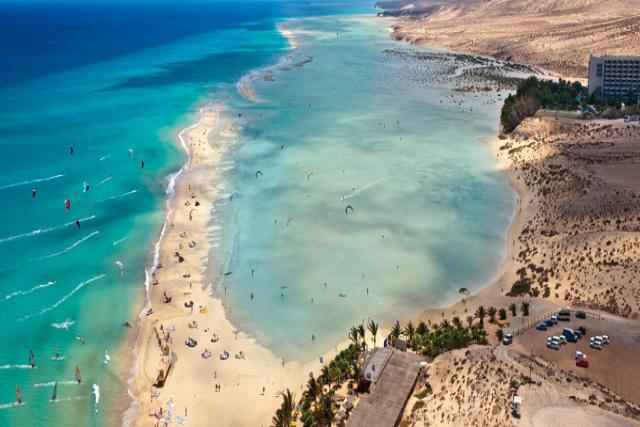
This spectacular beach is located within the municipality of Pajara, in the northern area of Sotavento beach, in Fuerteventura, and is considered one of the best beaches on the entire island. Its white sand extends between 100 meters and 300 meters from the shore and is not usually very crowded, which avoids crowds.
One of the characteristics of this beach is the wind, which during the vast majority of the year is usually strong. This has given it one of the most important events in the world of Windsurfing and Kiteboarding, as it has been the venue for the world championship for more than 30 years.
This competition has given it international fame by bringing together thousands of people who love these sports. In addition, during those days the tourist offer congregates in what is known as the "Carpa", an area where you can enjoy a wide range of activities, gastronomy and nightlife. Events such as 'The 80's Party', 'Beer Party' or 'White Party', among others, are also held there.
 3
Like
Published at 12:48 AM Comments (0)
3
Like
Published at 12:48 AM Comments (0)
Embracing the Flavours of Healthy Spanish Cuisine
Wednesday, January 22, 2025

Spain is renowned for its vibrant culture, rich history, and beautiful landscapes. However, one of the greatest treasures this Iberian nation offers is its culinary tradition, deeply rooted in the Mediterranean diet. Declared a Cultural Heritage and Intangible Asset by UNESCO, the Mediterranean diet is a vibrant tapestry of flavours and traditions that showcases a healthy and sustainable way of living. Let's embark on an exquisite journey through some iconic Spanish dishes that not only tantalise the taste buds but also offer a host of nutritional benefits.
Gazpacho and Salmorejo: The Quintessential Cold Soups
A staple in homes across Spain, especially during the hot summer months, are the refreshing cold soups, Gazpacho and Salmorejo. Both hailing from Andalucía, these dishes highlight the country's love for tomatoes as a primary ingredient. Gazpacho, the more liquid of the two, is often complemented by a crisp bite of cucumber and the subtle sweetness of peppers. In contrast, Salmorejo is richer and more robust in texture, often garnished with cured ham to enhance its savoury character. The added extra virgin olive oil, a Mediterranean gem, infuses each spoonful with a burst of flavour, providing essential healthy fats.
Tortilla Española: A Versatile Classic
The Spanish omelette, known as Tortilla Española, represents simplicity at its finest. Loved for its ease of preparation, this dish is versatile enough to fit into any meal or occasion. The key to its allure lies in the texture of the potatoes, the fluffy embrace of the eggs, and the unmistakable flavour brought by olive oil. Whether served warm or cold, accompanied by a slice of rustic bread, the tortilla is a testament to the harmonious blend of humble ingredients.
Paella: The Culinary Flagship of Valencia
Among Spain's most celebrated dishes, paella stands out as a culinary icon, originating from the sunny fields of Valencia. Traditionally prepared in a wide, shallow pan known as a paellera, the dish revolves around rice imbued with the golden hue and aromatic allure of saffron. Classic Valencian paella features tender pieces of chicken or rabbit, complemented by garrofó (a native bean), creating a symphony of flavours synonymous with the region. Cooking paella over a wood fire imparts a uniquely smoky essence, inviting one to savour not just the dish but the very soul of Valenciana terroir.
Escalivada: A Celebration of Roasted Vegetables
Escalivada is an emblematic Catalonian dish that showcases the Mediterranean reverence for fresh produce. The preparation involves slow-roasting an array of vegetables, such as aubergines, peppers, onions, and artichokes, either over embers or in an oven, allowing their natural juices to caramelise. Once assembled on a plate, the vegetables are drizzled with extra virgin olive oil and optionally a touch of vinegar, offering a delightful contrast of sweet and tangy notes.
Delicacies from the Sea: A Maritime Affection
With its extensive coastline, Spain is blessed with a wealth of seafood, and its culinary traditions reflect this maritime abundance. From Galicia’s rugged shores to the sunlit beaches of Valencia, seafood is celebrated in its many forms. The simple preparation of mussels, clams, and octopus, often boiled or lightly seasoned, lets their natural sweetness shine through. Notable dishes such as pulpo a feira, featuring boiled octopus sprinkled with paprika, and mariscada, a luxurious seafood platter, echo the ocean's melody in every bite.
Pistos and Tumbets: Rustic Vegetable Medleys
Emphasising the bounty of local gardens, dishes like pisto Manchego and tumbet are hearty concoctions of sautéed vegetables. The familiar aromas of onions, courgettes, tomatoes, peppers, and garlic mingle to create a vibrant medley. In Castilla-La Mancha, pisto is often enriched with a luscious fried egg, while in the Balearic Islands, tumbet showcases a layered assembly. Variants such as Andalucía’s alboronia and the Catalonian and Valencian samfaina are also popular, each offering its unique regional twist.
Blue Fish: A Nutritional Powerhouse
Spain’s culinary repertoire would be incomplete without its celebrated blue fish varieties. These nutrient-dense fish, including anchovies, tuna, sardines, and mackerel, are rich in Omega-3 fatty acids, making them a heart-healthy choice. Traditional preparations include Málaga's espetos, skewered sardines roasted over open flames, and Cantabria's preserved anchovies. The marmitako, a hearty tuna and potato stew from the north, showcases Spain's affinity for blue fish in a comforting, rustic form.
Abundance of Fresh Fruits and Vegetables
No exploration of Spanish cuisine would be complete without acknowledging its extraordinary variety of fresh fruits and vegetables. As Europe’s orchard, Spain offers a cornucopia of seasonal produce. Autumn is marked by apples, pears, and grapes, while winter welcomes the burst of citrus such as oranges and clementines. Spring heralds the arrival of strawberries, cherries, and loquats, and summer blooms with melons, watermelons, and plums. The Canary Islands, with their tropical climate, present a bounty of exotic options, including the ever-popular banana.
Embarking on a culinary journey through Spain offers more than just a feast for the senses; it is an invitation to experience a lifestyle that celebrates balance, quality, and health. The very essence of the Mediterranean diet exemplifies a harmonious blend of flavours, nutritional wholesomeness, and cultural traditions passed down through generations. As you savour each of these Spanish delights, remember that at their heart lies not only taste but a profound respect for the land and its bounty—a true testament to the joie de vivre that defines Spain.
This vibrant mosaic of dishes is a meal for the palate and the soul, ensuring that anyone who indulges in these treats leaves with a sense of culinary satisfaction and a touch of Spanish warmth. So, embrace the richness of Spanish gastronomy, knowing that each dish offers a delightful tapestry of tradition, taste, and health.
 0
Like
Published at 10:02 AM Comments (0)
0
Like
Published at 10:02 AM Comments (0)
Exploring Bilbao in Two Days: Your Essential Guide
Saturday, January 18, 2025

Nestled in the heart of the Basque Country, Bilbao stands as a testament to architectural innovation, rich history, and culinary excellence. You might be wondering how to capture the essence of this vibrant city in just 48 hours. Worry not, for this guide will walk you through a carefully curated itinerary that balances modern marvels with traditional charm. From iconic structures to hidden local treasures, get ready to explore Bilbao like a seasoned traveller.
Day 1: Modern Marvels and Panoramic Views
Your journey into Bilbao begins with a morning that promises both heights and insights. Start your day with breakfast at the legendary Café Iruña, located near the quaint Gardens of Albia. Established in 1903, this historic café is beloved by both locals and visitors for its character and classic Spanish tapas.
Ascend to Spectacular Heights
Once your morning hunger is sated, take a brief stroll to the elegant Bilbao City Hall. Snap a photo or two before making your way to the Artxanda Funicular, a cable railway that delivers stunning panoramic views of the city from the summit of Mount Artxanda.
Bridging Modern Architecture
Descend and cross the Zubizuri Bridge, designed by the visionary architect Santiago Calatrava. This striking white structure, resembling a sailing boat, is a precursor to the city's devotion to innovative design. As you walk through, take in the dramatic backdrop of the Isozaki Atea Towers, crafted by Japanese architect Arata Isozaki.
The Guggenheim Experience
All paths seem to lead to the centrepiece of Bilbao's skyline—the Guggenheim Museum. Famous for its stunning curvaceous titanium-clad design by Frank Gehry, the museum is more than just a building; it's a landmark of contemporary art. Outside, be greeted by Louise Bourgeois's towering spider sculpture, Maman, and Jeff Koons's floral phenomenon, Puppy. If time permits, venture inside to explore both permanent and temporary exhibitions that delve into the world of modern and contemporary art.
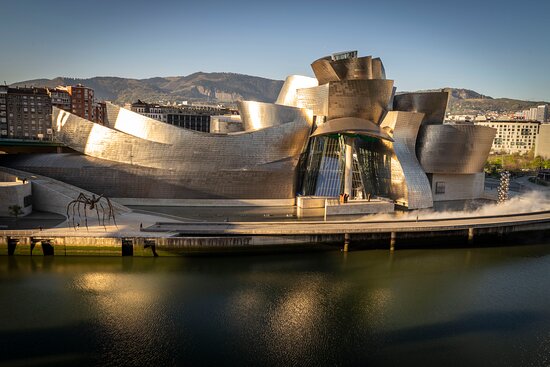
Afternoon Delight: Culture and Cuisine
Your cultural journey continues after lunch. Cross the modern Pedro Arrupe Footbridge to catch a glimpse of the University of Deusto, an iconic historical building. Return via the Deusto Bridge and meander through Avenida Abandoibarra, where you’ll encounter another architectural masterpiece, the Euskalduna Conference Centre and Concert Hall. This venue hosts an array of performances and exhibitions, making it a cornerstone of Bilbao’s cultural scene.
Immerse in the Azkuna Zentroa
Wind down at the esteemed Azkuna Zentroa (Alhóndiga Bilbao). Once a wine warehouse, this hub has been imaginatively transformed by designer Philippe Starck into a cultural epicentre. It boasts exhibition halls, cinemas, a design corner, and even a restaurant. If visiting in summer, its terrace is the perfect place to sip a cool beverage, enjoying a serene atmosphere.
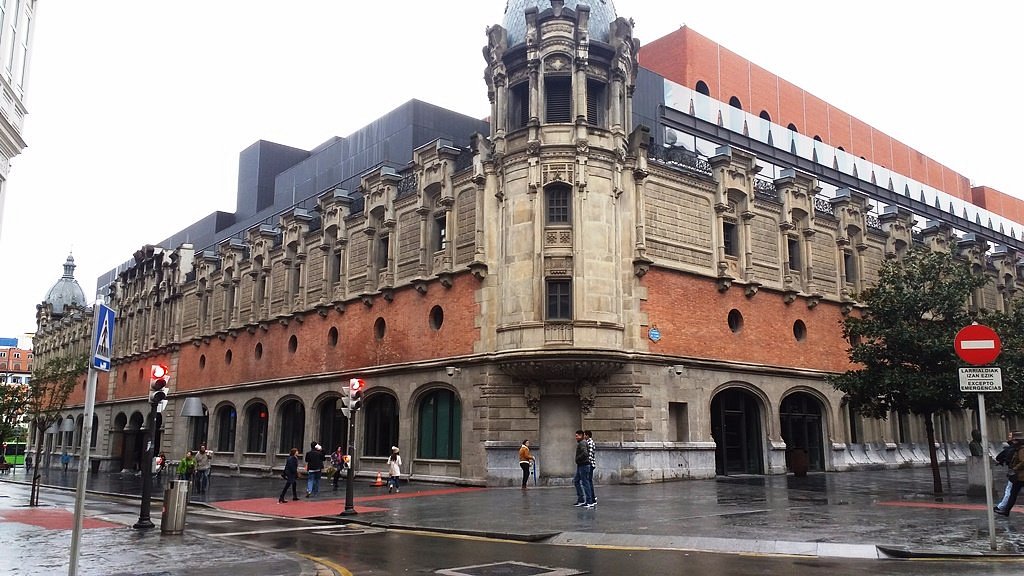
Day 2: Traditional Charm and Local Flavours
Today, immerse yourself in Bilbao's rich history and vibrant local culture as you wander through the Casco Viejo (Old Town).
Morning Spirituality at the Basílica de Begoña
Begin with a visit to the Basilica of Begoña, a revered site offering commanding views of the city. The basilica is dedicated to the Virgin of Begoña, dearly loved by the maritime community. A rather picturesque route leads you down the Mallona Steps to Unamuno Square, the ideal place to pause for coffee and people-watch.
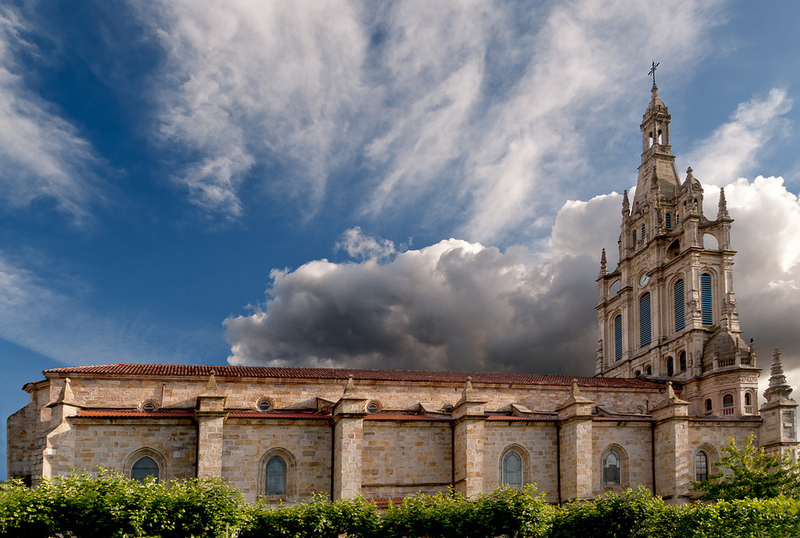
Discover the Seven Streets
Venture into the historic heart of Bilbao, exploring the famed “Siete Calles” or Seven Streets. These cobblestone lanes are perfect for a leisurely wander. Visit the Ribera Market, one of Europe’s largest covered markets, for a taste of fresh produce, meats, and the quintessential Basque pintxos. This local delicacy, akin to tapas, provides a gourmet experience in miniature form.
Significant Sights and Savoury Stops
In this traditional quarter, discover significant landmarks, including the Church of San Antón, Santiago Cathedral, and the Stock Exchange Building. Near the Stock Exchange, note the ground star that marks the singular spot from where the Basilica of Begoña is visible along the Seven Streets.
Afternoon Traditions
If your visit coincides with a Sunday, head to Plaza Nueva for the weekly market, where locals swap antiques and curiosities. The plaza's abundance of pintxo bars is perfect for sampling other regional treats, perhaps accompanied by a glass of Txakoli, the Basque Country’s celebrated white wine.
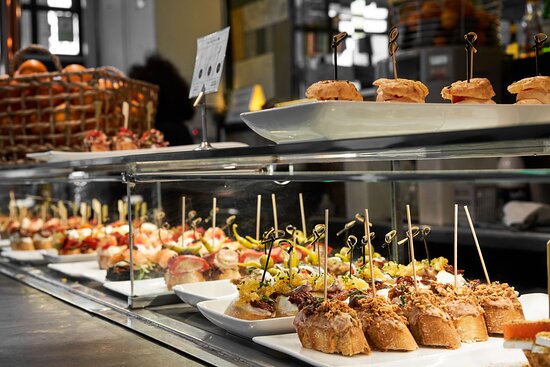
Artistic Evenings at the Arriaga Theatre
In the afternoon, make your way to the majestic Arriaga Theatre, inspired by the Paris Opera, and ideally located near Plaza Nueva. Whether attending a performance or simply admiring its beaux-arts façade, it's an enriching cultural highlight.
As your two-day adventure in Bilbao concludes, reflect on the eclectic mix of experiences the city has to offer. From avant-garde architecture to traditional Basque culture, Bilbao presents a fascinating contrast that captures the imaginations of all who visit. Whether you’re a fan of art, architecture, or gastronomy, Bilbao's diverse offerings ensure a truly unforgettable journey. As you depart, the city's remarkable spirit will likely leave you longing for a return visit.
 2
Like
Published at 10:21 AM Comments (0)
2
Like
Published at 10:21 AM Comments (0)
Fiestas de Moros y Cristianos de Bocairent: A Celebration of History and Culture
Saturday, January 18, 2025
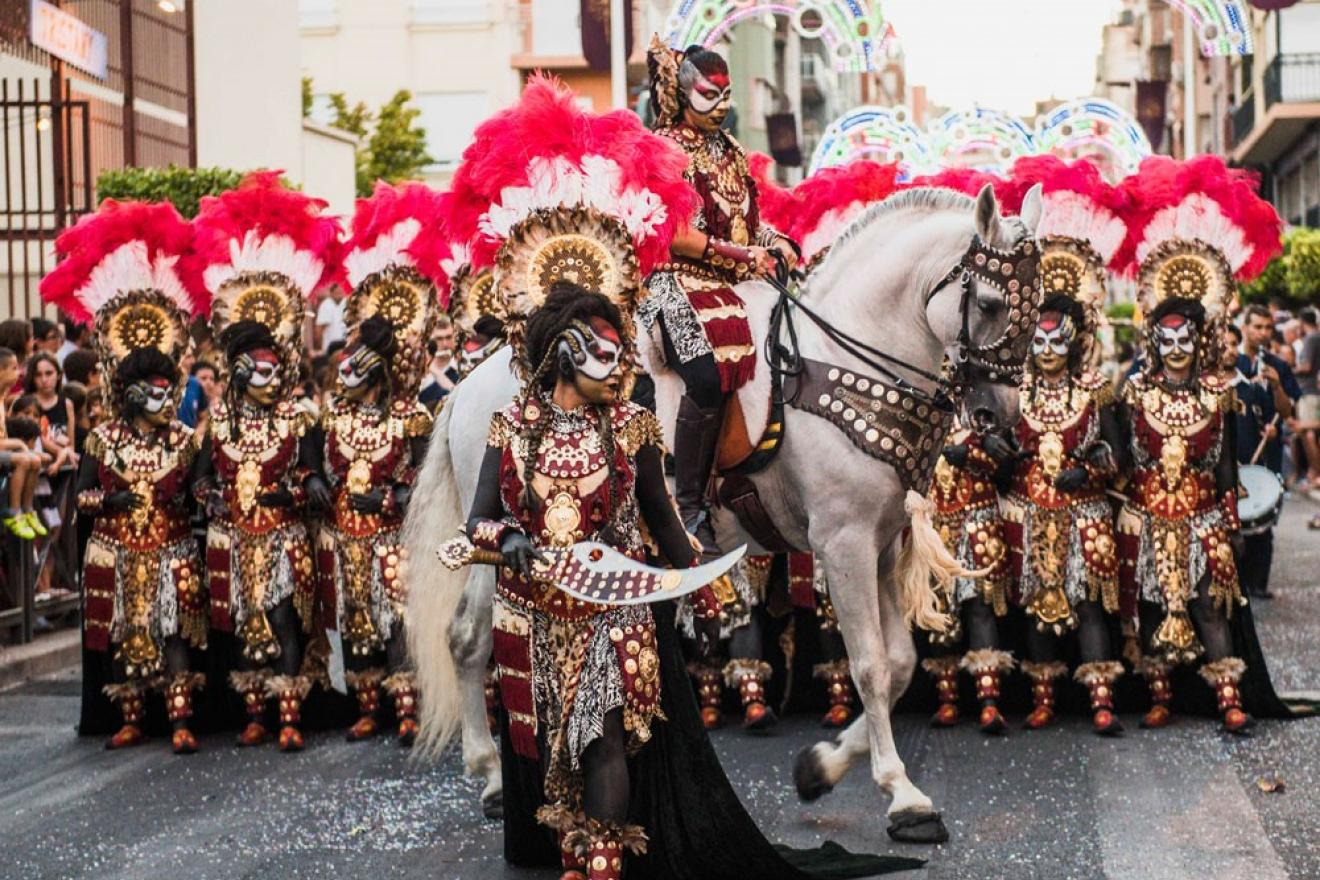
Nestled in the heart of Spain, the picturesque town of Bocairent hosts one of the most vibrant and historically rich festivals in the region — the Fiestas de Moros y Cristianos. Celebrated annually, this festival draws visitors from all over the world, eager to witness the spectacular reenactments, elaborate costumes, and the profound sense of tradition that permeates the event.
The Fiesta de Moros y Cristianos de Bocairent is traditionally held in early February to coincide with the feast day of Saint Blas (St. Blaise), which is February 3rd. Typically, the festivities begin on the weekend closest to this date and last for several days.
In 2025, February 3rd falls on a Monday. Therefore, the main celebrations will likely occur from Saturday, February 1st, through Tuesday, February 4th. However, it is best to check with official Bocairent resources or local authorities for the precise dates and schedule of events closer to the time, as specific dates and activities can vary annually.
Origin of the Fiesta
The Fiestas de Moros y Cristianos de Bocairent have their roots set deep in Spain’s medieval past, specifically in the period of the Reconquista, which spanned from the 8th to the 15th century. This was a time of prolonged conflict between the Christian kingdoms and the Moorish forces who occupied large areas of the Iberian Peninsula.
The festival celebrates the historical battles between the Moors (Muslims) and the Christians, culminating in the eventual Christian reconquest of the territory. More specifically, it commemorates the legendary figure of Saint Blas (St. Blaise), the patron saint of Bocairent. The festival also highlights the town's deep religious devotion and its historical identity, both of which are intertwined with tales of valour and unity.
Traditions Associated with the Fiesta
Grand Parades and Processions
The festival kicks off with grand parades featuring participants dressed in intricate costumes representing Moors and Christians. Each side has its "filaes" (groups), with members donning impressive, historically inspired clothing, complete with armour, robes, turbans, and vibrant decorations.
- Entrada de Moros y Cristianos: This is a highly anticipated event where both factions parade through the streets in a grand spectacle, showcasing their elaborate costumes and synchronized formations to the sound of traditional music.
Historical Reenactments
Central to the festival are the reenactments of the battles between the Moors and Christians. These staged combats, complete with pyrotechnics and theatrical performances, bring the medieval conflicts to life, captivating audiences with their authenticity and drama.
- Embajadas: These are formal speeches delivered by representatives of both Moors and Christians before the simulated battles. They echo historical negotiations and war declarations, adding a layer of narrative to the proceedings.
Solemn Religious Ceremonies
Given the festival's dedication to Saint Blas, religious devotion plays a significant role throughout the celebration.
-
Procession of Saint Blas: A solemn procession takes place, where the statue of Saint Blas is carried through the streets by the faithful. It is a moment of deep religious fervour and communal reverence.
-
Mass and Offerings: Special masses are held in honour of Saint Blas, with offerings collected for the church and local charities.
Music and Dance
Music and dance are integral to the Fiestas de Moros y Cristianos de Bocairent. Traditional bands perform throughout the festival, providing a soundtrack that blends military marches with celebratory tunes.
- La Marcha Mora and La Consagración: These are examples of the distinct musical styles played during the celebrations, reflecting the fusion of Moorish and Christian cultural elements.
Community Engagement
The festival is not just a spectacle for outsiders but a deeply communal event that involves almost every resident of Bocairent. Families, local groups, and individuals all take part in the preparations and celebrations, contributing to the festival's vibrant atmosphere.
The Fiestas de Moros y Cristianos de Bocairent is more than just a festival; it is a living history lesson, a cultural extravaganza, and a testament to the town’s rich heritage. It provides a bridge between past and present, allowing both residents and visitors to immerse themselves in the traditions that have shaped Bocairent’s identity. Whether you are drawn by the history, the pageantry, or the communal spirit, this festival offers a uniquely enchanting glimpse into Spain’s storied past.
 0
Like
Published at 9:50 AM Comments (0)
0
Like
Published at 9:50 AM Comments (0)
A Village that Whispers Legends
Saturday, January 11, 2025
Imagine a place where time stands still, where cobbled streets whisper tales of knights and princesses, and where the reddish houses seem straight out of a fairytale. That place exists, and it is called Albarracín.
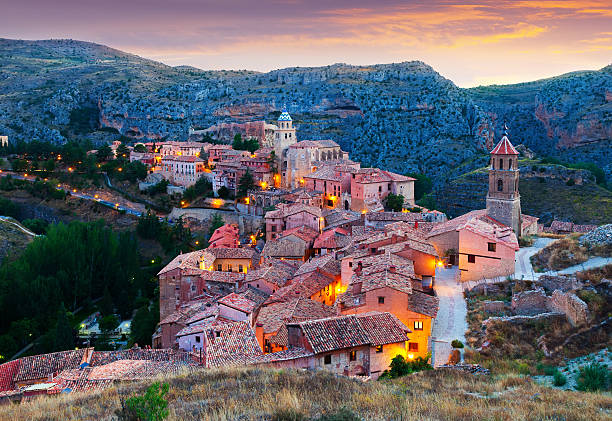
Perched on a rocky hill, like an eagle watching the horizon, this medieval village will transport you to a dream world. Surrounded by the waters of the Guadalaviar River, Albarracín will enchant you with its timeless beauty and magical atmosphere, woven with threads of real history that will move you.
Lose yourself in the labyrinthine alleyways, where each stone holds the echo of a fascinating past. Albarracín was an important Muslim fortress in the 11th century, an impregnable bastion that dominated the territory. Its name, of Arabic origin, evokes the memory of the brave Berber warriors who inhabited it, the Banu Razin, whose history is intertwined with legend. It is said that a young prince, exiled from his land, found refuge in these mountains and fell madly in love with a beautiful Christian woman. Their forbidden and impossible love was the seed from which Albarracín was born.
After the Christian reconquest, Albarracín became a coveted trophy, disputed by kingdoms and nobles. Its walls witnessed epic battles, such as the one that pitted the armies of Pedro III of Aragon and Alfonso X of Castile in the 13th century. But they were also scenes of palace intrigue and secret love. It is said that Queen Doña Blanca, wife of Pedro III, was locked up in the castle of Albarracín by her husband, a victim of jealousy and court conspiracies. She sadly contemplated the landscape from her window, longing for freedom and lost love.

Walk along the wall, which winds like a protective dragon around the village. From the top, contemplate the impressive landscape that stretches out at your feet, with the Guadalaviar River shining like a silver ribbon. Don't be surprised if you feel like a character in a period film, surrounded by a beauty that seems unreal. Legend has it that on full moon nights, the spirit of Queen Doña Blanca appears on the wall, seeking the peace she did not find in life.
Enter the castle, a fortress that has defied the passage of time. Explore its towers and walls, imagine the battles fought in its courtyards, and feel the thrill of living history. It is said that in the castle's dungeons, hidden secret passages lead to a hidden treasure waiting to be discovered by an adventurous soul.
Albarracín is a place to lose and find yourself. Get lost in its cobbled streets, discover secret corners, and admire the stately homes with their wooden balconies and courtyards full of flowers. Stop at the Plaza Mayor, where jousting and tournaments were once held and where today the locals gather to chat and enjoy life. Sit on a terrace to enjoy the local gastronomy, savour traditional dishes such as roast lamb or migas, and let yourself be carried away by the tranquil rhythm of life in this magical village.
Albarracín is a hidden treasure in the Sierra de Teruel, which will captivate you with its beauty, history, and magic. It is a perfect destination for those seeking an authentic experience away from the hustle and bustle of the big cities. Discover Albarracín and be seduced by its medieval charm, its legends and the true stories that have woven its soul over the centuries.
 4
Like
Published at 1:07 AM Comments (0)
4
Like
Published at 1:07 AM Comments (0)
The Beloved Siesta
Friday, January 10, 2025
The siesta, that sacred pause amidst the hustle and bustle of the day, is much more than just a restorative nap in Spain. It's a journey through time, a tradition deeply rooted in the country's history and culture, a custom that refuses to disappear despite the frenetic pace of modern life. It's a ritual that evokes images of quiet villages, lowered blinds, the sound of cicadas and the aroma of home-cooked food wafting through the air.
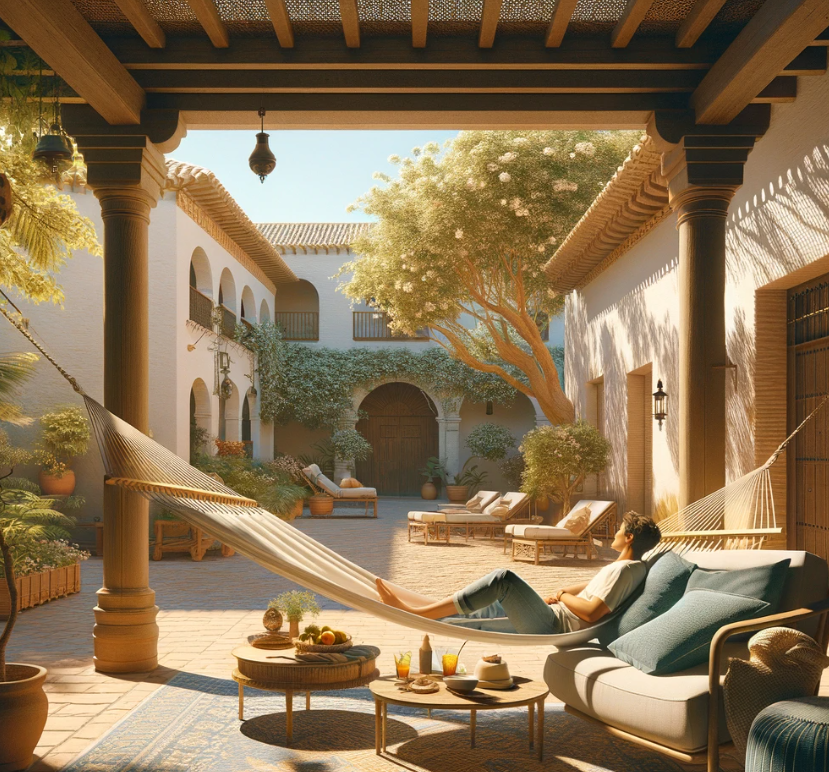
A legacy with roots in antiquity
To understand the siesta, we must return to ancient Rome, where we find its deepest roots. The word comes from the Latin "sexta", which refers to the sixth hour of the day, counted from dawn to approximately midday. With their ancestral wisdom, the Romans already recognised the importance of pausing in the middle of the day to rest and regain strength, especially during the hot summer months. This practice spread throughout the Roman Empire, including Hispania and present-day Spain.
The Arab influence and the flourishing of the siesta
With the arrival of the Arabs to the Iberian Peninsula in the 8th century, the custom of the siesta not only remained but became even more entrenched. The Arabs, accustomed to the hot desert climate, also practised resting during the hottest hours. During the Al-Andalus period (711-1492), the siesta became fully integrated into Spanish culture and enriched with new influences. It became a time for socialising, sharing a light meal and conversing with family and neighbours.
The siesta in the rural world
For centuries, the siesta has been an integral part of life in Spain, especially in the rural world, where farmers used it to escape the scorching heat and regain energy after long days of working in the fields. Life in the countryside followed the rhythm of the sun, and the siesta adapted to this natural cycle. At midday, when the sun was at its zenith, agricultural work stopped, and families gathered to eat and rest.
Much more than just a rest
The siesta is not limited to mere sleep. It is a pause to disconnect from the outside world, relax and reconnect with oneself. Traditionally, it was a time to share with family and neighbours, enjoy a light meal and chat about the day's events. It was an opportunity to strengthen social ties and cultivate coexistence. Although the siesta is less practised nowadays, it remains an essential element of Spanish culture, a symbol of a slower and more humane pace of life where rest and well-being are valued.
The siesta in the modern era
In the 20th century, with industrialisation and the rise of big cities, the siesta began to lose ground. The pace of life accelerated, working hours lengthened, and the pressure for productivity increased. However, the siesta refuses to disappear. Various scientific studies have demonstrated its multiple benefits: it reduces stress, improves mood, increases concentration and productivity, and strengthens the immune system. Large companies, such as Google or Nike, have begun to incorporate rest spaces for their employees, recognising the value of this ancient practice.
The siesta: a legacy for the future:
The siesta is a cultural legacy Spain offers to the world, an invitation to reconsider our relationship with time and rest. In an increasingly fast-paced world, the siesta reminds us of the importance of listening to our bodies, enjoying the small pleasures in life and cultivating calm amid the storm. It is a reminder that well-being is not only found in productivity but also balance and harmony. The siesta invites us to reconnect with our natural rhythm, appreciate the value of rest, and live more fully.
 4
Like
Published at 2:11 AM Comments (0)
4
Like
Published at 2:11 AM Comments (0)
The Second Most Romantic Hotel in the World
Friday, January 3, 2025
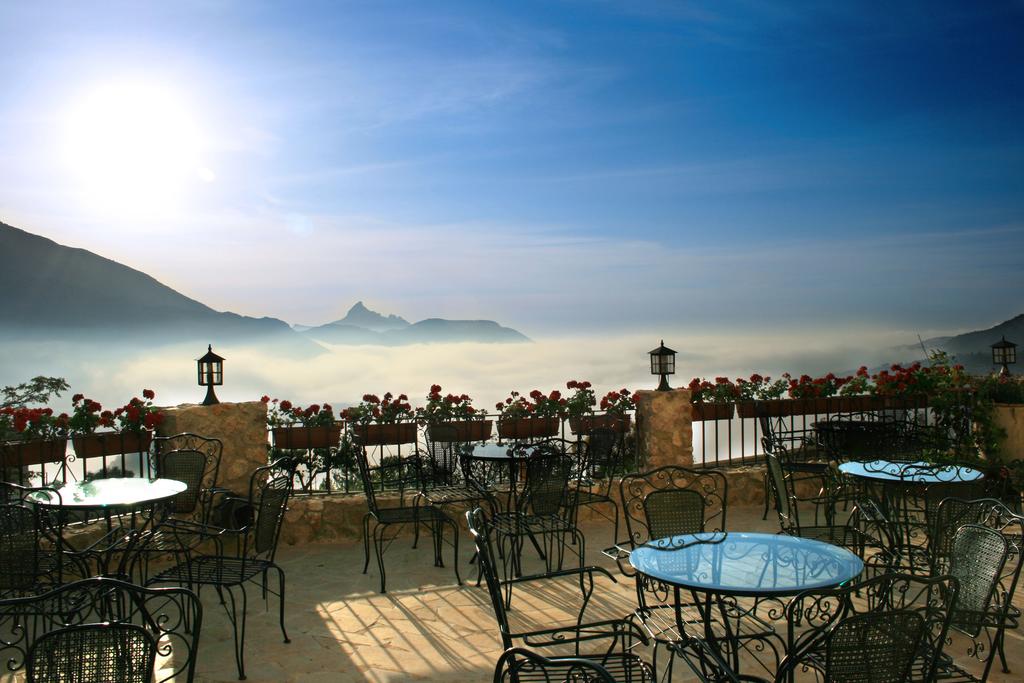
A small hotel in Guadalest has been voted the second most romantic in the world by users of the specialised travel website TripAdvisor, the most visited globally.
The rural complex Cases Noves is located in the urban area of the municipality, it has only five rooms and clients can stay there from 131 euros per night. Guadalest, which has just over 200 inhabitants, is located in the Alicante region of Marina Baja, 20 kilometres from the touristy Benidorm.
This small town in Alicante has been recognised as a Historic-Artistic Complex since 1974 and is also part of the Association The Most Beautiful Towns of Spain.
This dream getaway that couples love occupies a 1932 country house that has been remodelled while respecting the original charm. The users of Tripadvisor consider it to be "a real treasure".
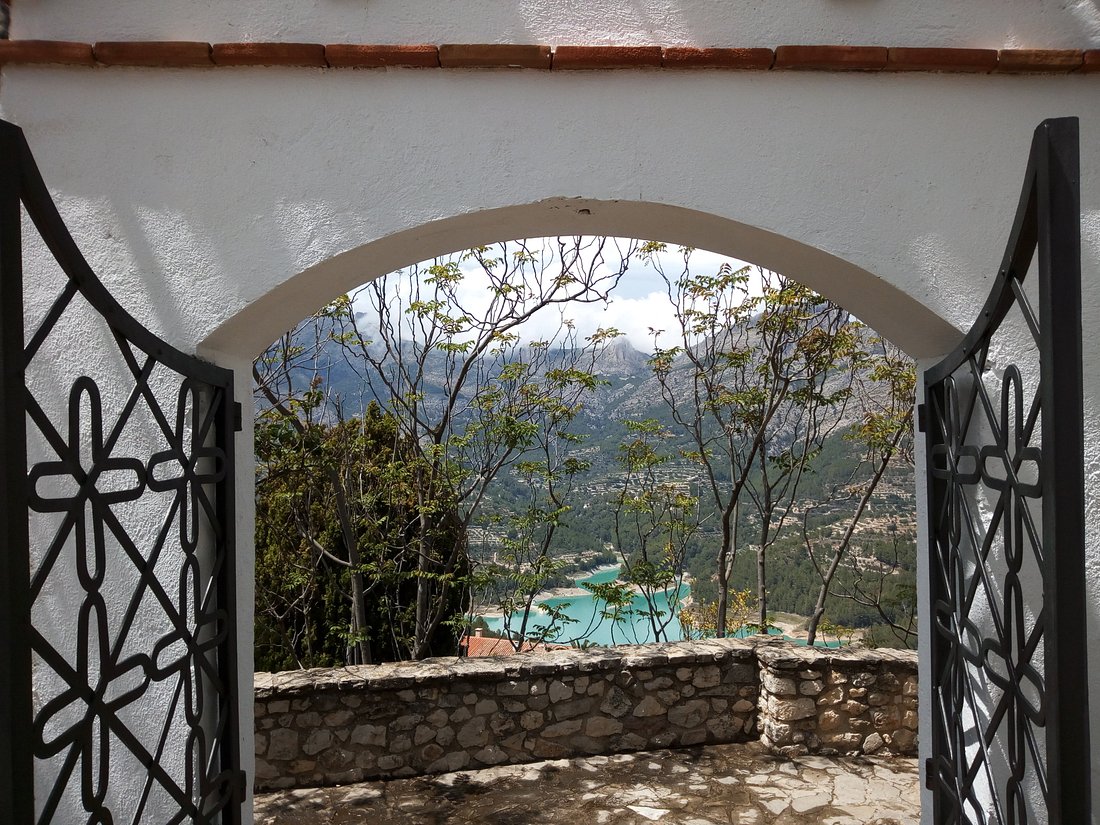
The hotel not only offers accommodation, but its team offers the client a myriad of activities and services. Among them, gourmet breakfasts, romantic dinners, Spa sessions to disconnect, wine tourism activities, hiking trails, as well as the possibility of organising celebrations. Also, there are those who choose this place to celebrate a small wedding.
One of the welcome packs offered by the hotel to surprise your partner offers an aphrodisiac cocktail, chocolates, scented candles and music to liven up the evening. The hotel team decorates your room in a romantic and personalised way.
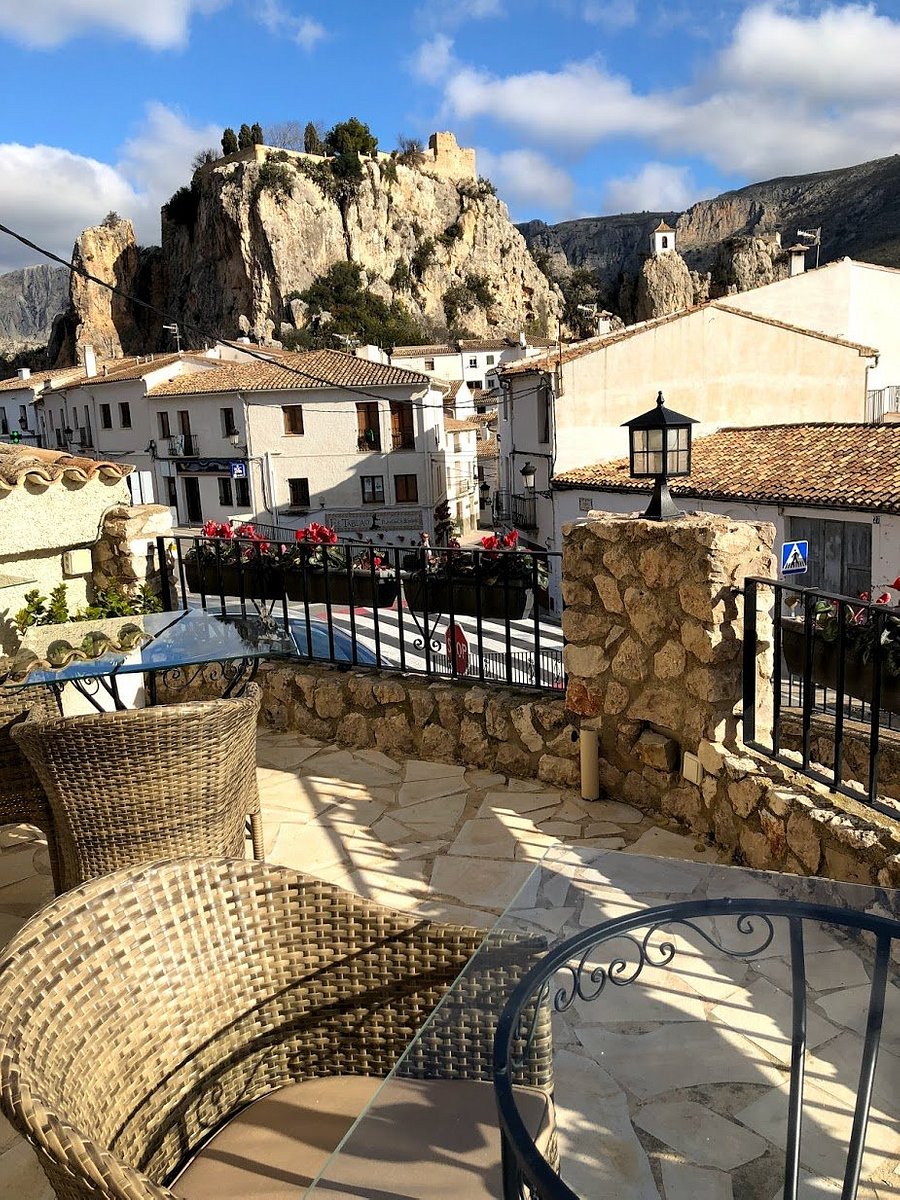
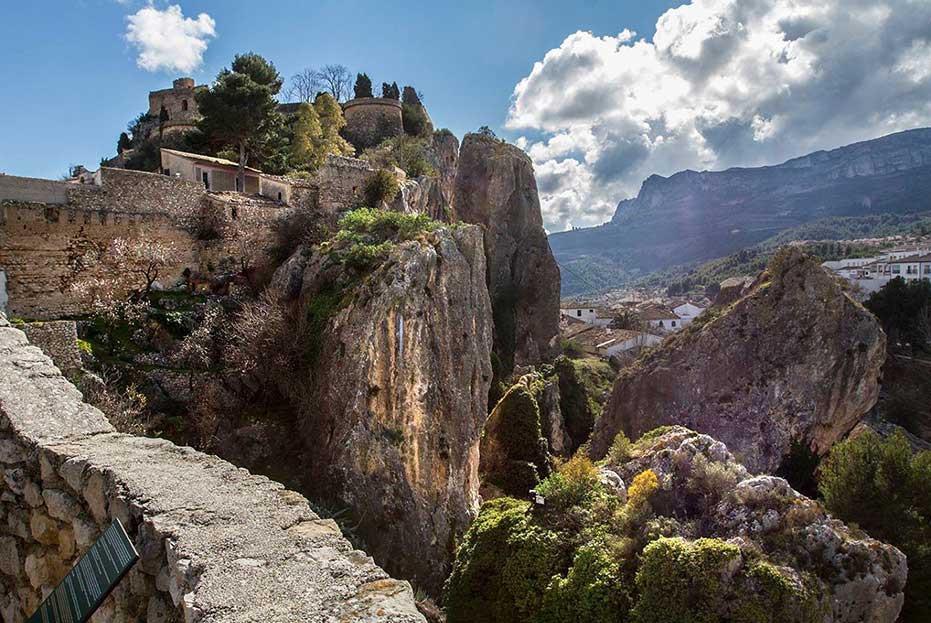
The rural complex is very well located, it overlooks the castle and has fabulous views of the mountainous landscape. From its windows, you can see the Aitana, Serrella and Xortà mountains, as well as the bay of Altea in the distance.
The property, owned by Sofía Alonso and Antonio Serrano, came into operation in July 2005. Since then it has received several recognitions from TripAdvisor and the Booking.com portal.
The Cases Noves is only surpassed as the most romantic by the Narrows Escape Rainforest Retreat hotel in Montville, Australia, within this category of "most romantic in the world" establishments.
 2
Like
Published at 6:29 PM Comments (0)
2
Like
Published at 6:29 PM Comments (0)
Spam post or Abuse? Please let us know
|
|